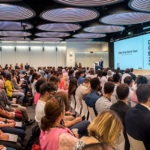How much time do attendees spend in sessions and on the show floor at your meeting? It’s a question that many organizers can answer only anecdotally or through labor-intensive efforts.
The American Association of Pharmaceutical Scientists (AAPS), for example, used to do “a one-time visual headcount during a session” at its conferences, said Grace Jones, AAPS’s director of meetings. “But our sessions are pretty fluid, and to get something that would give us that information without involving more staff time would be a great savings for us.”
So Jones jumped at the chance to beta-test Experient’s new eventBit — a platform that tracks attendee behavior in real time — at AAPS’s 2016 National Biotechnology Conference (NBC) in Boston this past May. Experient already handled registration and lead retrieval for AAPS, so adding eventBit to the mix at the 1,200-attendee NBC 2016 seemed natural. The platform uses a small, battery-powered transmitter — affixed to the back of a name badge — to broadcast information about an attendee’s movements to Experient’s lead-retrieval devices, which are distributed throughout the venue. Clients such as Jones can look at that information in real time on their laptop, tablet, or phone.
“It was the first show where we used it to track the activities in sessions or common areas or the show floor,” said Mike Godsey, senior vice president of market development for Experient. “We met with Grace every night [during NBC]. It was great for us, because she was looking at the data live, going, ‘Oh, look at this!’ They could see traffic, up and down, and started to attribute it to certain speakers that were in the room being able to deliver better content.”
But the data went beyond how many people were in what room, also showing who they were and how much time they spent in a given location. “We were able to see, for a particular session, the demographics of the audience — what scientific area they worked in,” Jones said. “In the exhibit area, [eventBit] can define the people who are just walking by a booth versus the people who are actually engaged with an exhibitor.”

It was a lot to take in — and a lot of useful data for AAPS to apply to future programs, including its 2016 Annual Meeting and Exposition, taking place in Denver this November, where eventBit will again be deployed. “We’ll be able to report back to our program committees: ‘This particular session was huge,’” Jones said. “We can report it to our social-media folks. It will also help our business development. [And in our reports] back to the exhibitors: ‘Okay, we’re seeing this amount of traffic in your area.’ ‘These people paused at your booth.’ We can use that data in different ways.”
After the Facts
A data-collection platform like eventBit can be a double-edged sword: It sucks up an enormous amount of data for clients — so much that it can be overwhelming. “I think that we’re probably leaving a lot of opportunity behind us or off the table if we don’t start to offer to take a look at all of that and start to make suggestions on behalf of the customer,” said Experient’s Mike Godsey, “and kind of be data experts.
“The concept when we built [eventBit] was really about making it so easy that the show organizer could look at it live in real time or after the event, to make real-time or post-event decisions about most anything,” Godsey said. “But we’re also thinking that we might want to have a data specialist or two that can meet and talk to every customer after the event — to talk about what some of the findings are and start to learn from each other, because if they don’t do something with the data, it’s kind of useless.”



